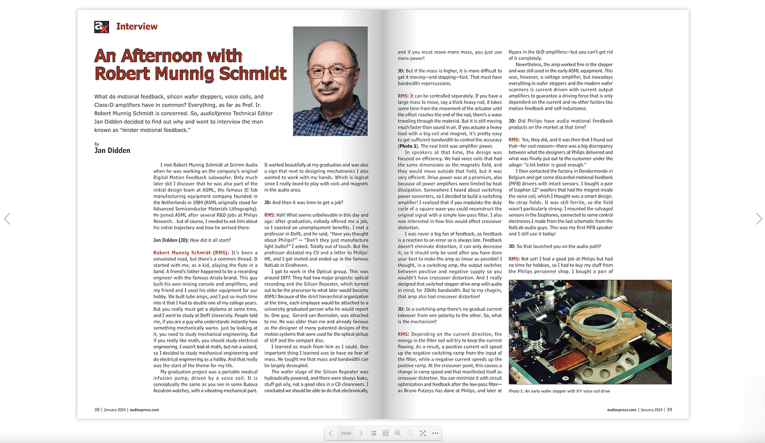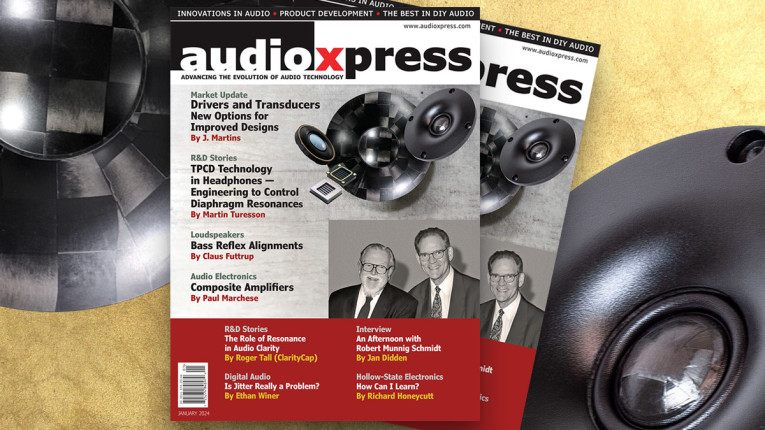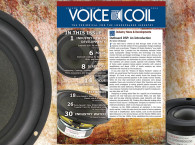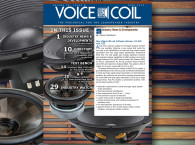 Focusing on Drivers and Transducers, this January 2024 issue opens with a Market Update detailing those technical options that deserved to be recognized for improved designs. From home speakers to high-end speakers, from soundbars to subwoofers, the world of transducers continues to evolve mostly outside of the spotlight, with crucial innovations occasionally breaking through. In this issue, audioXpress highlights the latest innovations from Composite Sound, Glass Acoustic Innovations Technology (GAIT), MISCO, Purifi Audio, SB Acoustics, Scan-Speak, SEAS Fabrikker, Merry Electronics, and Tang Band Speaker.
Focusing on Drivers and Transducers, this January 2024 issue opens with a Market Update detailing those technical options that deserved to be recognized for improved designs. From home speakers to high-end speakers, from soundbars to subwoofers, the world of transducers continues to evolve mostly outside of the spotlight, with crucial innovations occasionally breaking through. In this issue, audioXpress highlights the latest innovations from Composite Sound, Glass Acoustic Innovations Technology (GAIT), MISCO, Purifi Audio, SB Acoustics, Scan-Speak, SEAS Fabrikker, Merry Electronics, and Tang Band Speaker.Continuing with loudspeakers, Claus Futtrup writes about Bass Reflex Alignments. As one of the creators of Speakerbench, a web-based speaker design tool, in collaboration with Jeff Candy, Claus Futtrup is in a unique position to discuss the evolution of enclosure designs based on this electrical filter theory, including the concept of an alignment chart. As he states, the use of standard filter alignments represents a foundational concept in the loudspeaker industry, with an impact nearly as significant as the invention of the electro-dynamic loudspeaker principle itself. And in this article, he takes us through the fundamental figures who have contributed to this chapter in loudspeaker history. A really fun journey and enjoyable article.
Next up, Martin Turesson (Composite Sound) describes how thin-ply carbon diaphragm (TPCD) technology can also be applied to headphones, allowing precise control of diaphragm resonances. As the speaker industry is recognizing how TPCD technology, introduced a solution to controlling the sources of diaphragm resonances, rather than trying to reduce its negative effects. As the pioneer of TPCD technology, Composite Sound is now entering the over-ear headphone market with its Metamodal TPCD engineering approach, enabling headphones with better sound quality, improved bass performance, and higher sensitivity.
Another great article is an interview that Jan Didden did recently with Robert Munnig Schmidt, a name that is intrinsically connected with advanced motion systems and motional feedback applications. Now retired from his own consultancy business, following an outstanding career that includes key R&D positions at Philips, being part of the ASML founding team, and teaching Mechatronic System Design at the Delft University of Technology, in this interview, Robert Munnig Schmidt revisits the theory and practice of motional feedback, silicon wafer steppers, voice coils, and Class-D amplifiers, and shares his passion for music and high-quality sound reproduction.

In R&D Stories, Roger Tall (ClarityCap) writes about the years of research between the audio capacitor manufacturer and the UK-based Institute of Acoustics at the University of Salford, exploring how the resonance from the body of a capacitor in a loudspeaker crossover circuit has an audible impact on sound quality. The article details the extensive testing, measurements, and conclusions, which allowed ClarityCap to perfect its manufacturing process, minimizing resonances in capacitors.
For those who like to dig deep into Audio Electronics, Paul Marchese offers a fairly in-depth analysis of composite amplifiers, including the effects of local as well as global feedback. In his exploration, Marchese looks at stability and debunks a few rules of thumb, before applying clever measurement techniques to measure the very low distortions that make a great composite power audio amplifier.
Continuing with Audio Electronics, Ethan Winer asks: Is Digital Jitter Really a Problem? Since the dawn of the digital era decades ago, the timing error known as "jitter" in A/D/A converters has been accused of harming audio fidelity. Some people claim that jitter adds audible distortion and noise, affects bass fullness, and even harms stereo imaging width and depth. This is an artifact that is difficult to generate artificially in controlled amounts so there haven't been many tests. In his article Winer explains what jitter is, what causes it, and — most important — lets you hear jitter in controlled amounts so you can decide for yourself how damaging it really is.
In this month's Hollow-State Electronics column, Richard Honeycutt answers the question: “How can I learn about vacuum tubes and circuits?" Learning about hollow-state electronics used to be as easy as DIY trial-and-error, getting information from a family member or friend, or reading technical books and magazines. Even today with all the information available online, finding a knowledgeable and patient mentor and lots of practice still seem to be key factors.

As we enter another year of audioXpress, we would like to gently remind you to renew your subscription for 2024. All the content contained in every issue of audioXpress, is the reason why, month after month, 12 times per year, this publication continues to reinforce its role as an essential resource for the audio industry. Your support and that of our advertisers is what allows us to keep this publication in print and all digital platforms and pay our independent authors and contributors for their work.
Subscribe if you haven't done so yet in order not to miss future issues or renew your subscription. Subscribing to the digital online version allows immediate access and is available here: audioXpress Subscription Services
If you wish to buy a single printed issue or the complete audioXpress archive on USB, from 2000 to 2024 (yes, including the latest issue), just visit our online shop at www.cc-webshop.com
Don't miss out, get your copy of audioXpress right now at www.gotomyxpress.com

Clarification
In page 8 of the January 2024 issue of audioXpress, a caption on a photo of the Scan-Speak Ellipticor range, stated "Manufacturing might come from Asia, but innovation is still very much based in Denmark," which seemed to imply that those products were manufactured in Asia.
This was corrected in the digital online version of the magazine. The sentence was intended as a generic remark, not specific to Scan-Speak but it can be understood differently. It should be clear that all Scan-Speak products are manufactured in Denmark with no exceptions.
Our apologies to Scan-Speak.






